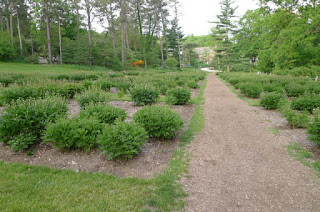The
National Park Service, which runs the Cherry Blossom Festival in Washington,
D.C., describes the cherry blossom as a symbol of the fleeting nature of human
life that also “epitomizes the transformation of Japanese culture throughout
the ages.”
In
celebration of that symbolic power and of Japan’s 1912 gift of trees, Matthaei Botanical Gardens & Nichols Arboretum is planting nearly 30 cherry-tree
seedlings at Matthaei and in the Arb near the Peony Garden. The seedlings,
germinated at Arbor Day Farm in Nebraska from seeds donated by Japan, were later
delivered to 23 arboreta and botanical gardens in 21 states. The Arb &
Gardens is the sole Michigan recipient of seedlings.
 |
| The weeping Higan cherry tree in full bloom last spring, Nichols Arboretum near Alex Dow Prairie. This magnificent tree was one of many cherry trees donated in the early 1950s by University of Michigan alumni living in Tokyo. |
The
seeds came from groves in Tokyo and Nara in south-central Japan, reportedly
from the same groves where the original 1912 cherry trees were grown, according
to Woodrow Nelson, Vice President Marketing Communications for Arbor Day
Foundation, which germinated the seeds last year. (The Japanese name is Prunus jamasakura Siebold ex. Kidzumi.
In the west, this tree is usually referred to as Prunus serrulata var. spontanea (Maxim.) E.H. Wilson.)
Timing
drove the decision to send seeds, according to Nelson. When it heard about the
centennial promotions, “Japan wanted to make the gift during the 2012 Cherry
Blossom Festival but didn’t have trees to send,” Nelson says, so they sent
seeds instead.
The
new trees not only provide a connection to the widely celebrated Washington
plantings and the friendship with Japan that they represent, says
Matthaei-Nichols Director Bob Grese, “they remind us of our strong cultural
connections with the people of Japan both at the University and in Michigan.”
The
cherry trees also enrich our collections of culturally significant plants, such
as the Nichols Arboretum Peony Garden, the Julie Norris Post Collection of
Ericaceous and Appalachian Plants, and the Centennial Shrub Collection in the
Arb.
A
National Event that Nearly Wasn’t
Today
a pilgrimage to see the cherry trees in bloom is a bucket-list essential, with
millions of visitors flocking to Washington each year to capture a lasting
memory of an ephemeral flower. Yet it took 24 years of letter writing by Elizah
Scidmore—an American writer, photographer, and geographer who had lived in
Japan—to get the U.S. government to plant them in the first place. The original
proposal to plant cherry trees in Washington was Elizah’s brainchild. Beginning
in 1885, she embarked on her long letter-writing campaign to convince the U.S.
government to plant cherry trees in the capital. Finally, in 1909, Scidmore’s
letter to first lady Helen Taft bore fruit when Taft promised to make the trees
a reality.
Unfortunately,
when the first shipment of trees from Japan arrived the following year, a USDA
inspection team, which included nematologist Nathan Cobb, discovered that the
trees were infested with nematodes. The trees had to be destroyed.
In
1912 Japan sent new cherry trees that passed inspection, and several were
planted around the Tidal Basin. Workmen continued planting trees there for the
next seven years, but it wasn’t until 1954 that the National Cherry Blossom
Festival officially began.
In
a 1946 letter, Harlow Whittemore wrote to A.C. Marshall, Detroit Edison’s past
president, “We have had inquiry recently from Tokyo with regard to the donation
made some years ago . . . for a Japanese cherry collection given by the
University alumni in that city.” Whittemore, a Professor in the University of
Michigan Department of Landscape Architecture from 1914-1958 and then U-M
Chairman of City Planning, envisioned “a great collection of flowering trees”
donated by Michigan alumni, one of which is the magnificent weeping Higan
cherry near the Alex Dow Field (pictured above). Today Arb visitors make their
own yearly pilgrimage to see the nearly 60-year-old tree. In a few short years,
new cherry blossoms will grace the Gardens and Arboretum, dazzling visitors
with nature’s display of renewal and transformation.
Go
Pink—and Blue
What
does the U-M have to do with Japanese cherry trees? Turns out there are two
Michigan connections—to the 1912 gift from Japan and to the idea of planting
cherry trees in the United States. The first is Frieda Cobb Blanchard, daughter
of Nathan Cobb, an inventor, scientist, accomplished artist, and “father of
nematology.”
As
a member of a United States Department of Agriculture inspection team, Cobb
discovered the 1912 shipment of cherry trees to be infested with
nematodes—small, often microscopic worms, many of which are parasitic. Because
of the nematodes, the cherry trees had to be destroyed. Frieda, who was born in
Australia, moved to Ann Arbor in 1916 and, while earning her doctorate in
genetics from the U-M, was appointed assistant director of the Botanical
Gardens at its location on Iroqouis Street. Blanchard lived in Ann Arbor until
her death in 1977.
The
other U-M connection is the Grand Rapids-born O. C. Simonds, the celebrated
landscape architect who studied at U-M and who designed Nichols Arboretum.
Simonds was a colleague and advisor of the noted plant explorer David
Fairchild, an early promoter of Japanese cherry trees long before they became a
fixture in American gardens. Fairchild’s efforts to promote the plant likely
helped inspire an American passion for the flowering cherry tree.









.jpg)








































